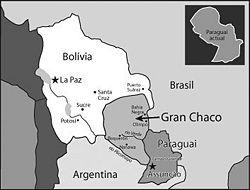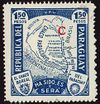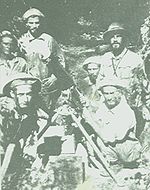Chaco War
| Chaco War, Interwar Period | |||||||||
|---|---|---|---|---|---|---|---|---|---|
 Bolivia and Paraguay before the 1932 War |
|||||||||
|
|||||||||
| Belligerents | |||||||||
| Commanders and leaders | |||||||||
| Daniel Salamanca Urey General Hans Kundt General Enrique Peñaranda |
Eusebio Ayala Marshal José Félix Estigarribia |
||||||||
| Strength | |||||||||
| 250,000 | 150,000 | ||||||||
| Casualties and losses | |||||||||
| 57,000 casualties | 43,000 casualties | ||||||||
The Chaco War' (1932–1935) was fought between Bolivia and Paraguay over control of the northern part of the Gran Chaco region (the Chaco Boreal) of South America, which was incorrectly thought to be rich in oil. It is also known as La Guerra de la Sed' or 'War of Thirst'. It was the bloodiest military conflict fought in the Americas during the 20th century.
Contents |
Origins
Though the region was sparsely populated, control of the Paraguay River running through it would have given one of the two landlocked countries access to the Atlantic Ocean. This was especially important to Bolivia, which had lost its Pacific Ocean coast to Chile in the War of the Pacific (1883).
In international arbitration, Bolivia argued that the region had been part of the original Spanish colonial province of Moxos and Chiquitos to which Bolivia was heir. Meanwhile, Paraguay had begun to colonize the region. Indeed, both Paraguayan and Argentinian planters already bred cattle and exploited quebracho woods in the area, while the small indigenous population of Guaraní-speaking tribes was related to that country's own Guaraní heritage.
Control of natural resources
Furthermore, the discovery of oil in the Andean foothills sparked speculation that the Chaco itself might be a rich source of petroleum. Foreign oil companies were involved in the exploration: companies mainly descended from Standard Oil backed Bolivia, while Shell Oil supported Paraguay. Standard was already producing oil from wells in the high hills of eastern Bolivia, around Villa Montes.

Oil wasn't offered as an explanation till after the war by Bolivia as an excuse to seize standard oil's assets.[1]
Paraguay had lost almost half of its territory to Brazil and Argentina in the War of the Triple Alliance and was not prepared to see what it perceived as its last chance for a viable economy fall victim to Bolivia.[2]
The War

Border skirmishes throughout the late 1920s culminated in an all-out war in 1932, after the Bolivian army, following orders of President Daniel Salamanca, attacked a Paraguayan garrison at Lake Pitiantuta in June. They later occupied another garrison further south, called Fortín Boquerón. This stronghold would later become the scene of one of the bloodiest and protracted battles of this war, when some 600 Bolivian soldiers resisted a 22-day siege, against 14,000 Paraguayan troops before surrendering (7-29 September 1932).
Paraguay had a population only a third as large as that of Bolivia (880,000 versus 2,150,000), but its guerrilla style of fighting, compared to Bolivia's more conventional strategy, enabled Paraguay to take the upper hand. In June 1932, the Paraguayan army totaled about 4,026 men (355 combat officers, 146 surgeons and noncombatant officers, 200 cadets, 690 NCOs, and 2,653 soldiers). Both racially and culturally, the Paraguayan army was practically homogeneous. Almost all of the soldiers were Spanish-Guarani mestizos. In Bolivia, however, most of the soldiers were Altiplano Indigenous Indians (90% of the infantry troops), the lower-ranking officers were of Spanish ancestry, and General Hans Kundt was German. In spite of the fact that the Bolivian army had many more soldiers, the Bolivian army never mobilized more than 60,000 men, and never more than two-thirds of the army were on the Chaco at one time, while Paraguay mobilized its entire army.[3] City buses were confiscated, wedding rings were donated to buy rifles, by 1935 Paraguay had widened conscription to include 17 year-olds and policemen.[4]
Paraguay received military supplies and intelligence from Argentina, and the Paraguayans took advantage of their ability to communicate over the radio in Guaraní, which was not intelligible to the typical Bolivian soldier. Paraguay had little trouble in mobilizing its troops in large barges on the Paraguay river right to the frontlines, whilst the majority of Bolivian soldiers came from the western highlands, some eight hundred kilometers away and with little or no logistic support. In fact, it took a typical Bolivian soldier about 14 days to traverse the distance, while a Paraguayan soldier only took about four.[3] The heavy equipment of Bolivia's army made things worse. The supply of water, given the dry climate of the region, also played a key role during the conflict. There were thousands of non-combat casualties due to dehydration, mostly among Bolivian troops.

A key battle of the Chaco occurred at Fortín Nanawa, about 60 miles Southeast of Boquerón. This fortín was considered by the Paraguayans to be the backbone of their defenses. Former Imperial Russia's officers Ivan Belaieff and Nicolas Ern (who were anti-communist Russians under the service of the Paraguayan army as the Head of the General Staff and frontline commander respectively) had focused greatly on the fortification of this fortín. It had zig-zag trenches, miles of barbed wire, and many machine-gun nests (some in the trees). On January 20, 1933, Kundt, in personal command of the Bolivian force, launched six to nine aircraft and 6,000 unhorsed cavalry, supported by twelve Vickers guns. The cavalry unit's horses had previously died because of dehydration. Under Kundt, three frontal assaults failed. The Bolivians succeeded in capturing a few of the outer trenches, but heavy rains forced them to abandon the attack, which allowed Paraguayans to reoccupy the entire complex. By the end of January the Bolivians suffered 2,000 casualties without making much progress. The Paraguayans lost only 248 men. The defeat seriously damaged Kundt's prestige. This fortín was later nicknamed the "Verdun of South America."[3] Partly due to costly frontal assaults of this nature, partly to the loss of the southern area of the Chaco by the end of 1933, Kundt was taken out of command and replaced by General Peñaranda.[5]
Moreover, Bolivia deployed at least three Vickers 6-Ton tanks during the war, in what was the first time (the second time was the use of M-3 Stuart tanks by El Salvador in the 1969 war against Honduras)[6] case of cross-border armoured warfare inside the Americas. These machines proved to be ill-suited to the terrain and climate of Gran Chaco, when compared with the lightly-armed Paraguayan forces.[7]
The Chaco War is also important historically as the first instance of large scale aerial warfare to take place in the Americas. Both sides made use of obsolete single-engined biplane bombers; despite an international arms embargo imposed by the League of Nations, Bolivia in particular went to great lengths in trying to import a small number of Curtiss T-32 Condor II twin-engined bombers masqueraded as civil transports, only to be halted in Peru during deliveries.[8]
The limited deployment of these "advanced" weapons caused enormous strains on both countries' impoverished economies, already stretched to the limit by war expenses.
The Paraguayan navy played a key role in carrying thousand of troops and supplies to the frontlines through the Paraguay River, as well as in providing antiaircraft support to transport ships and port facilities.[9] 2 Italian gunboats, the Humaita and Paraguay ferried troops to Puerto Casado though neither did any fighting. On 22 December 1932, three Bolivian Vickers Vespa attacked the riverine outpost of Bahía Negra, killing a Paraguayan army colonel, but losing one of the aircraft, shot down by the gunboat Tacuary. The two surviving Vespas met another gunboat, the Humaitá, while flying downriver. Paraguayan sources claim that one of them was damaged.[10] At Ballivian, the last ever dogfight between bi-planes took place.[11] The Paraguayan navy air service was also very active in the conflict, harassing Bolivian troops deployed along the northern front with flying boats. The aircraft were moored at Bahía Negra Naval Air Base, and consisted of two Macchi M.18.[12] These seaplanes carried out the first night air attack in South America when they raided the Bolivian outposts of Vitriones and San Juan,[13] on 22 December 1934. Every year since then, the Paraguayan navy celebrates the 'day of the Naval Air Service' on the anniversary of the action.[14]
While the military conflict ended with a comprehensive Paraguayan victory,[15][16] from a wider point of view it was a disaster for both sides. Bolivia's European elite forcibly enlisted the large indigenous population into the army, though they felt little connection to the nation-state, while Paraguay was able to foment nationalist fervour among its predominantly mixed population. On both sides, but more so in the case of Bolivia, soldiers were ill-prepared for the dearth of water or the harsh conditions of terrain and climate they encountered. The effects of the altitude had maimed the Bolivian army: most of the indigenous soldiers lived on the cold Altiplano at altitudes of over 12,000 feet. They found themselves at a physical disadvantage when called upon to fight in sub-tropical temperatures at almost sea level.[17] In fact, of the war's 100,000 casualties (about 57,000 of the total were Bolivian), more died from diseases such as malaria and other infections than from the actual fighting. At the same time, the war brought both countries to the brink of economic disaster.
On November 27, 1934, Bolivian generals, frustrated by the progress of the war, seized President Salamanca while he was visiting their headquarters in Villa Montes and replaced him with the vice-president, José Luis Tejada.
Aftermath


By the time a ceasefire was negotiated for noon June 10, 1935, Paraguay controlled most of the region. In the last half hour there was a senseless shoot-out between the armies.[18] This was recognized in a 1938 truce, signed in Buenos Aires, Argentina, by which Paraguay was awarded three-quarters of the Chaco Boreal, 20,000 square miles. 2 Paraguayans and 3 Bolivians died for every square mile. Bolivia did get the remaining territory, that bordered the Paraguay's River Puerto Busch. Some years later it was found that there were no oil resources in the Chaco Boreal kept by Paraguay, yet the territories kept by Bolivia were, in fact, rich in natural gas and petroleum, these being at the present time, the country's largest exports and source of wealth.
Paraguay captured 21,000 soldiers and 10,000 civilians (1% of Bolivians), many chose to stay after the war, they were called Los Bolivianos. 10,000 Bolivian troops had run away to Argentina or self-mutilated. Paraguay also took 2,300 machine guns, 28,000 rifles and ammunition worth $10 million (enough to last 40 years).[19]
The country's stunning military blunder during the Chaco War led to a mass movement known as the Generación del Chaco, away from the traditional order, [20] which was epitomised by the MNR-led Revolution of 1952.
A final treaty clearly marking the boundaries between the two countries was not signed until April 28, 2009.[21]
Cultural references
Some aspects of the Chaco War are the inspiration for Tintin's comic book adventure The Broken Ear by Hergé, which began publication in 1935.
The conflict inspired Lester Dent to write the Doc Savage adventure The Dust of Death, also in 1935.
The Chaco War formed the backdrop for the 1935 film Storm Over the Andes, by Christy Cabanne, and the 2006 minimalist film Hamaca paraguaya, by Paz Encina.
One of the masterpieces of Paraguayan writer Augusto Roa Bastos, the 1960 novel Hijo de Hombre, describes in one of its chapters the carnage and harsh war conditions during the siege of Boquerón. The author himself took part in the conflict, joining the army medical service at the age of 17. The Argentine movie Hijo de Hombre, directed by Lucas Demare in 1961 is based on this part of the novel.
Howard Chaykin’s 2009 mini-series Dominic Fortune begins with the title character working as a mercenary pilot in the Chaco War.
In Pablo Neruda's poem, Standard Oil Company, Neruda refers to the Chaco War in the context of the influences that oil companies had on the existence of the war.
See also
- Vickers 6-Ton tank
- Carden Loyd tankette
- Junkers W 34
- List of wars involving Paraguay
Notes
- ↑ At the tomb of the inflatable pig, page 332
- ↑ The Chaco War
- ↑ 3.0 3.1 3.2 Scheina, Robert L. "Latin America's Wars Volume II: The Age of the Professional Soldier, 1900-2001." Washington D.C.: Brasseys, 2003.
- ↑ At the tomb of the inflatable pig, page 333 and 337
- ↑ Hartzler Zook,David (1961). The conduct of the Chaco War. Bookman Associates, p. 168
- ↑ Herard von Santos "El Salvador-Honduras War Ilustrated"
- ↑ Chaco War armor
- ↑ Dan Hagedorn and Antonio L. Spaienza, Aircraft of the Chaco War 1928-1935, Schiffer Publishing Ltd, Atglen PA, 1997, ISBN 0764301462
- ↑ Landlocked navies
- ↑ Dávalos, Rodolfo: Actuación de la marina en la Guerra del Chaco: puntos de vista de un ex-combatiente. El Gráfico, 1974, page 69. (Spanish)
- ↑ At the tomb of the inflatable pig, page 336
- ↑ Hagedorn & Sapienza, pp. 61-64
- ↑ Scheina, page 102
- ↑ Los Ecos del primer Bombardeo Nocturno en la Guerra del Chaco, Chaco-Re, No. 28 (julio/septiembre 1989), 12-13. (Spanish)
- ↑ "Paraguayan victory in the Chaco War doubled the national territory and worked wonders for national pride." Chasteen, John Charles (2001). Born in Blood and Fire: A Concise History of Latin America. Norton, p. 176. ISBN 0393050483
- ↑ "The architect of the Paraguayan victory was General Estigarribia, who fought a brilliant war of maneuver." Goldstein, Erik (1992). Wars and peace treaties, 1816-1991. Routledge, p.185. ISBN 0415078229
- ↑ English, Adrian J. "The Green Hell: A Concise History of the Chaco War Between Bolivia and Paraguay 1932-1935." Gloucestershire: Spellmount Limited, 2007.
- ↑ At the tomb of the inflatable pig, page 339
- ↑ At the tomb of the inflatable pig, page 337
- ↑ Gómez, José Luis (1988). Bolivia, un pueblo en busca de su identidad Editorial Los Amigos del Libro, p. 117. ISBN 8483701413
- ↑ Bolivia, Paraguay Settle Border Conflict from Chaco War
External links